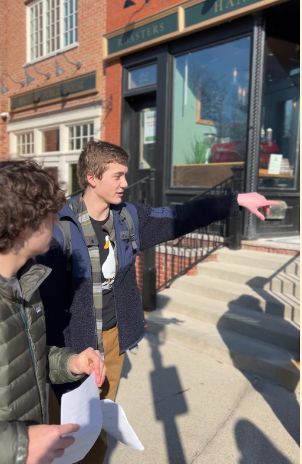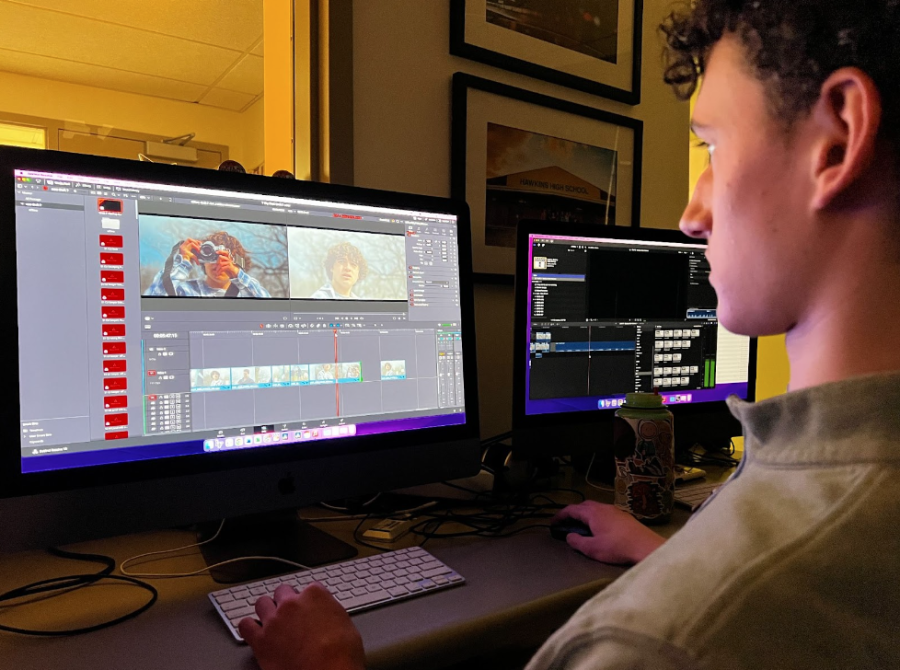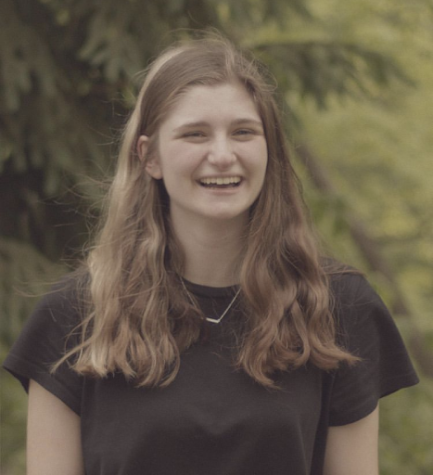What a Shot: New Media produces a short film in just a week
Junior Simon Pasquesi edits the team’s film. The group had just seven days to write, act, and edit the film.
March 23, 2023
A short film can take weeks, months, or even years to produce but New Media has found a way, year after year, to create one in just seven days.
The New Media program participates in the 7 Day Challenge from the Midwest Media Educators Association where they have to write, film, and edit a short film in just one week.
“Everybody in Chicago gets the same two props, and a line of dialogue and they all have the same requirements. It’s seven minutes in seven days,” Mr. Steve Douglass said.
In this crunch time, students use what they have gathered from other projects to guide their work ethic going into such a demanding task.
To come up with a solid foundation for the film, Douglass said students need to “solve that puzzle” of what the story is going to be.
“Once we got the story on the board, it gave a very specific direction to the writing group,” Douglass said.
This then sets up the group for further success in the filming stage of the process.
Prior projects such as anatomy of a scene (where students devise their own interpretations of film scenes) allowed for students to get a feel of what a leadership role looks like, and prepared the class for what would normally occur boiled down into just seven days.
The short film was a few juniors led alongside seniors who have gone through the process last year. It creates a space where juniors who have not had the opportunity to take that next step in leadership can do so.
Junior Ryder Gamrath stepped up and took on his first major project as the Director.

“The night before I was like ‘I’m going to be the cool director, I’m going to be chill’ and then I got there and it was the most stressful thing I’d ever experienced. It was crazy,” he said.
But with such a limited amount of time, none of it could be wasted on moments of fear and doubt.
“I got less stressed throughout the day because I got more comfortable with it and I also learned how to rely on my crew more,” Gamrath said.
It was about how they dealt with the circumstances that shaped the way the film turned out. There are on the fly calls made and the rest of the team has to learn to adapt to the situation.
“It’s not something you can just walk into. You have to be prepared for it. That’s the unique fun of it as well because you get to see how students truly react to that pressure,” Douglass said. “Some kids step up and other kids it’s not the opportunity for them to do that.”
Seven days pass with no time to waste, as the first two are spent ideating and writing, then the next day is spent filming, and the rest are left for time to edit.
Junior Milana Yanev had a plethora of roles working on the project, as she stepped outside of her comfort zone as the Lead Editor.
She faced one of the many challenges when they decided to go off-script for a scene. That meant more risk of the audio and mouths not lining up in sync.
“It was a lot of give and take towards the end. I’m a pretty big perfectionist and you have to pick and choose what you want to focus on,” Yanev said.
As Gamrath and Yanev collaborated with their peers to create a project they were proud of, it included deciding what challenges were more imperative to spend their time on.
“You have to learn to pick and choose your battles,” Yanev said.
Yanev could spend “the next two years” editing the film but in the end, it’s about making the best choices time allows for.
On the spot decisions were made daily while working with such a tight timeline.
While filming the last day, the lead actor, Zac Goodspeed suggested to Gamrath that he bring his mother’s chocolate lab into the scene.
“I immediately said yes…not only because of the fun idea but it was also because I knew that he was trying to help the short film in any way possible and so I trusted him with his ideas and he was right. It worked really well,” Gamrath said.
As the Director, it was Gamrath’s job to make the big decisions that would best benefit the group as a whole. Taking the extra step to ensure the project was produced at such a high quality allowed for teamwork to grow.
“There’s a lot more real-world experience in that,” Douglass said.
But, this is only a step in the direction of larger projects to come next year.
“We are building toward the All American High School Film Festival which is at the end of October. That’s the project that has changed kids’ lives,” Douglass said.
This project serves not only as an experience for students but also as a formative time to learn how to adapt to situations to better prepare them for a higher stakes competition.
Like every taskNew Media works on, Douglass calls it “just a step in the journey” on the way to projects that will challenge students to a greater extent.
7 Day serves not only about film experience but about working with a group of peers to create something unified.
“We focus on it because it brings kids together and it gives students a chance to meaningfully collaborate and really be able to do things they otherwise wouldn’t be able to do in class,” Douglass said. “The whole program comes together.”







